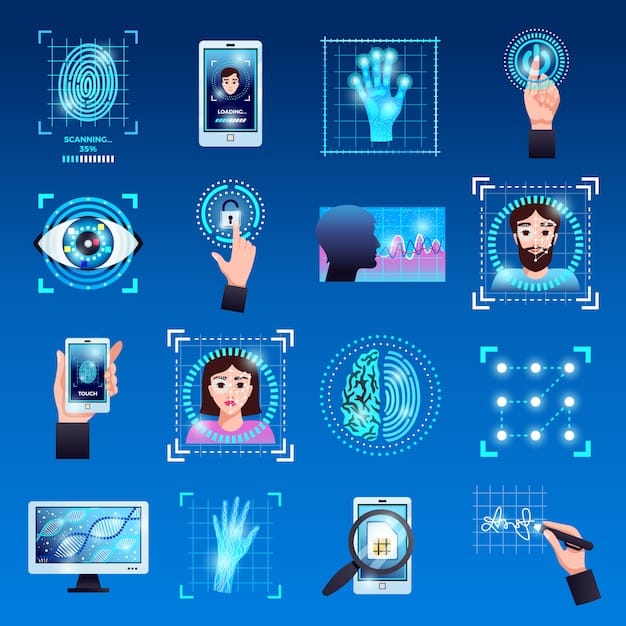Biometric Authentication Security: Preventing Spoofing and Protecting User Data

Biometric authentication security is crucial for protecting user data by preventing spoofing attacks through advanced technologies and robust security measures, ensuring accurate and reliable identity verification.
In an era where digital security is paramount, biometric authentication security stands as a critical defense. Ensuring that only authorized individuals gain access to sensitive data necessitates robust measures to prevent spoofing and safeguard user information.
Understanding Biometric Authentication Security
Biometric authentication is the process of verifying a person’s identity based on unique biological traits. These traits can include fingerprints, facial features, iris patterns, and even voice recognition.
Unlike passwords or PINs that can be forgotten or stolen, biometrics offer a more secure and convenient method of authentication. However, the security of biometric systems is not foolproof and requires constant vigilance.
Types of Biometric Authentication
Biometric authentication methods vary in terms of accuracy and security. Each type has its own strengths and weaknesses that are crucial to understand.
- Fingerprint Scanning: This is one of the most common and widely used biometric methods, involving scanning the unique ridge patterns on a person’s finger.
- Facial Recognition: Facial recognition technology identifies individuals by mapping and analyzing facial features from a photograph or video.
- Iris Scanning: This method uses unique patterns in the iris of the eye to verify identity, often considered more secure than fingerprint scanning.
- Voice Recognition: Analyzing the unique characteristics of a person’s voice to confirm their identity. It is often used for phone-based authentication.

Biometric authentication methods have significantly improved security over traditional password-based systems. Understanding how these methods work helps in appreciating their potential vulnerabilities and the need for robust security measures.
The Threat of Biometric Spoofing
Biometric spoofing, also known as presentation attacks, involves tricking biometric systems into accepting a fake biometric sample as a genuine one. These attacks can compromise the security of biometric authentication.
Attackers use various techniques to create replicas of biometric traits. Without proper safeguards, even advanced biometric systems can be deceived.
Common Spoofing Techniques
Attackers continually devise new methods to circumvent biometric security. Understanding these techniques is essential for developing effective countermeasures.
- Fake Fingerprints: Creating artificial fingerprints using materials like silicone, gelatin, or even play-doh to mimic genuine fingerprints.
- Facial Spoofs: Using printed photos, videos, or 3D masks to impersonate someone’s face in front of a facial recognition system.
- Voice Mimicry: Employing voice synthesis or recordings to imitate someone’s voice, fooling voice recognition systems.
- Contact Lenses: Using specialized contact lenses printed with iris patterns that mimic valid users to bypass Iris scanning.
Recognizing the ingenuity of spoofing attacks is the first step in enhancing biometric authentication security measures. A multi-layered defense strategy should always be employed.
How to Prevent Biometric Spoofing
Preventing biometric spoofing requires a combination of hardware and software solutions. These measures ensure that biometric systems are robust and resistant to various types of attacks.
Effective spoofing prevention involves not only detecting fake samples but also verifying the liveness of the person providing the biometric data.
Liveness Detection Techniques
Liveness detection is the key to differentiating between genuine users and spoofing attempts. These techniques verify that the biometric data is being captured from a live person.
- Challenge-Response Systems: Asking the user to perform a random action, such as blinking or smiling, to verify their liveness during facial recognition.
- Multispectral Imaging: Using different wavelengths of light to capture detailed information about the skin’s surface and subsurface, detecting fake fingerprints made from non-organic materials.
- Voice Pattern Analysis: Analyzing the nuances and irregularities of a person’s voice to distinguish it from synthesized or pre-recorded speech.
- Micro-Movement Detection: Detecting subtle movements in the iris or facial muscles that are difficult to replicate in a spoof.

The inclusion of liveness detection technologies significantly improves the security and reliability of biometric systems. Regular updates and enhancements to these technologies are necessary to keep ahead of evolving spoofing techniques.
Enhancing User Data Protection
Protecting user data in biometric authentication systems requires robust security measures beyond spoofing prevention. Data encryption and secure storage are essential components.
Encryption ensures that biometric data is unreadable to unauthorized parties. Secure storage prevents data breaches and unauthorized access.
Best Practices for Data Security
Implementing best practices for data security can significantly reduce the risk of data breaches and unauthorized access. These are crucial for ensuring data integrity and confidentiality.
- End-to-End Encryption: Encrypt biometric data from the point of capture to the point of storage, ensuring that it remains secure during transmission and at rest.
- Secure Storage: Implement secure storage solutions with access controls and regular audits to prevent unauthorized access to biometric databases.
- Anonymization and Tokenization: Use anonymization and tokenization techniques to replace sensitive biometric data with non-sensitive identifiers, reducing the risk of data exposure.
- Compliance with Standards: Adhere to industry standards and regulations, such as GDPR and CCPA, to ensure compliance with data protection requirements.
Ensuring robust security measures for protecting user data is imperative in maintaining trust in biometric authentication systems. Regular audits and compliance checks also contribute to long-term data protection.
Future Trends in Biometric Security
Biometric security is an evolving field, with new technologies and methods emerging regularly. Staying informed about these trends is essential for maintaining robust security systems.
Emerging trends include AI-driven security solutions and multimodal biometric authentication, which combines multiple biometric modalities for enhanced security.
Emerging Technologies and Methods
Staying ahead of emerging trends and technologies is crucial for implementing cutting-edge biometric security measures. Anticipating and preparing for these advancements ensures proactive security.
- AI-Driven Anomaly Detection: Using artificial intelligence to analyze biometric data for anomalies and unusual patterns that may indicate a spoofing attempt.
- Multimodal Biometrics: Combining multiple biometric modalities, such as face and voice recognition, to strengthen the authentication process and make it more difficult to spoof.
- Behavioral Biometrics: Analyzing patterns such as typing speed, gait analysis, and mouse movements to create a unique behavioral profile for each user.
- Blockchain for Biometric Data: Using blockchain technology to securely store and manage biometric data, ensuring data integrity and preventing unauthorized modifications.
The future of biometric security lies in adopting innovative technologies and staying adaptive to emerging threats. Continuous research and development are essential for advancing the field.
Implementing a Comprehensive Biometric Security Strategy
A comprehensive biometric security strategy requires a holistic approach that encompasses technology, policy, and user awareness. By addressing all these factors, businesses create a robust security posture.
This strategy includes regular risk assessments, employee training, and continuous system monitoring and updates.
Key Components of an Effective Strategy
Implementing a comprehensive strategy involves integrating various components that work together to ensure robust security. These components cover technology, user awareness, and policy frameworks.
- Regular Risk Assessments: Conduct routine risk assessments to identify potential vulnerabilities and threats in the biometric system.
- Employee Training: Provide employees with comprehensive training on biometric security policies and procedures, helping them recognize and report potential security incidents.
- Continuous System Monitoring: Implement continuous system monitoring to detect and respond to security breaches in real-time.
- Regular Software Updates: Keep biometric systems up-to-date with the latest security patches and software updates to protect against known vulnerabilities.
By implementing a holistic strategy, businesses can leverage the benefits of biometric authentication while maintaining a high level of security. Continuous evaluation and improvement are essential for keeping up with evolving threats.
| Key Point | Brief Description |
|---|---|
| 🛡️ Spoofing Prevention | Using liveness detection to verify genuine users. |
| 🔒 Data Encryption | Securing biometric data during transfer and storage. |
| 🤖 AI-Driven Detection | Utilizing AI to identify anomalous biometric patterns. |
| 🤝 Multimodal Biometrics | Combining multiple biometric traits for added security. |
Frequently Asked Questions
▼
Biometric spoofing is the process where someone attempts to deceive biometric systems by using fake biometric samples, aiming to impersonate a legitimate user and bypass security protocols.
▼
Liveness detection techniques ensure that biometric data is being captured from a live person, verifying responses like blinking or analyzing multispectral imaging to prevent using fake samples.
▼
Data encryption protects sensitive biometric information by making it unreadable to unauthorized parties during transmission and storage, reducing the risk of exposure and data breaches.
▼
Multimodal biometrics combines multiple different biometric modalities like facial recognition and voice analysis to create a more secure authentication process that is harder to spoof.
▼
Regular risk assessments help identify vulnerabilities within biometric systems, allowing organizations to proactively address potential threats, implement necessary updates, and ensure ongoing protection against attacks.
Conclusion
In conclusion, ensuring biometric authentication security requires a multi-faceted approach that combines advanced technology, robust security policies, and continuous vigilance. By focusing on preventing spoofing, protecting user data, and staying ahead of emerging threats, businesses can create secure and reliable biometric authentication systems that protect their valuable assets and sensitive information.





